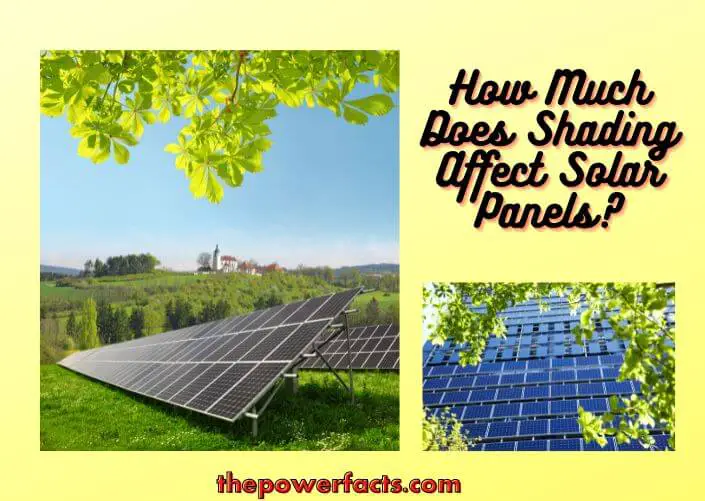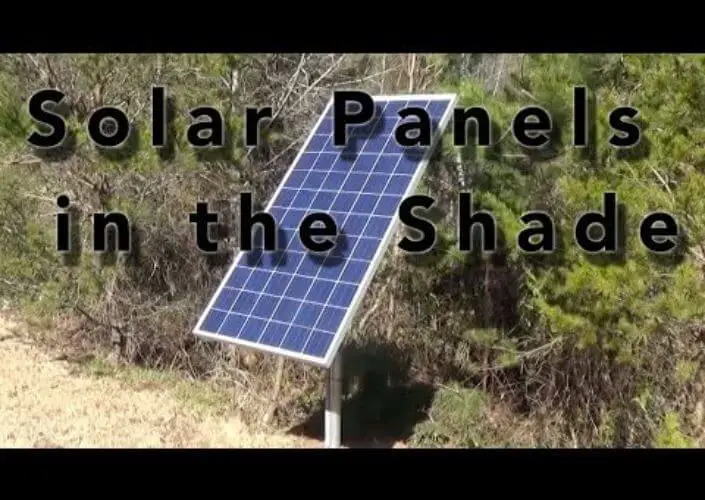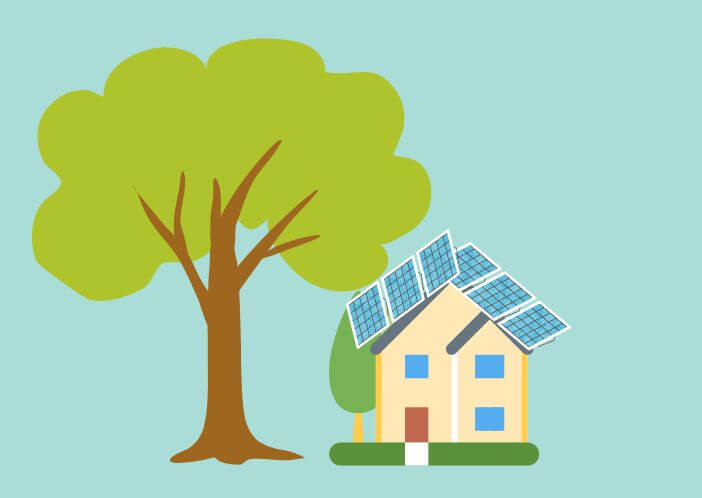Published on: September 17, 2022
Written by Ferris Gregor / Fact-checked by Nova Scarlett
Shading is one of the most important factors to consider when installing solar panels. Even a small amount of shading can reduce the output of a solar panel by a significant amount. The best way to avoid shading issues is to have an experienced installer assess your property and determine the best location for the panels.

Solar panels are a great way to save money on your energy bill. But how much do they actually save you? It turns out that shading can have a big impact on how much solar panels can save you.
Shading from trees, buildings, or other obstacles can reduce the amount of sunlight that hits your solar panel. This means that your solar panel will produce less power, and you’ll see a decrease in your energy savings. In some cases, shading can reduce the power output of a solar panel by up to 80%.
So if you’re thinking about installing solar panels, be sure to take into account any potential shading issues. It’s important to make sure that your solar panel will get as much sunlight as possible in order to maximize your energy savings.
How Much Does Shade Reduce Solar Panel Output?
Solar panels are most efficient when they are directly exposed to sunlight. Shade from trees, buildings, or other objects can reduce the amount of sunlight that reaches the solar panel and decrease its output. The amount of power lost to shading depends on how much of the panel is shaded, the angle of the sun, and the type of solar panel.
Shading can have a significant impact on solar panel output. Even a small amount of shade can decrease output by up to 20%. If you are considering installing solar panels, it is important to take into account any potential shading issues.
Trees and tall buildings are common sources of shade, but anything that casts a shadow on the solar panel can reduce its output. In general, it is best to avoid installing solar panels in areas that are prone to shading. If you cannot avoid shading, there are ways to mitigate its effects.
For example, using a higher-efficiency solar panel or mounting the panel on a tracking system so that it follows the sun can help offset some of the power lost to shading.
How Do You Keep Solar Panels from Shading?
Solar panels need direct sunlight to function properly, so it’s important to keep them free from shading. Here are a few ways to do that:
-Trim trees and other vegetation around the solar array.
-Place panels on a south-facing roof or in an open area.
-Install adjustable mounts that allow you to angle the panels for optimum sun exposure.
-Use reflective material to deflect shade from nearby buildings or objects.

How to Calculate Shading on Solar Panels?
When it comes to solar power, one of the most important factors is shading. Shading can come from trees, buildings, or other objects and can significantly reduce the amount of power that your solar panels are able to produce. There are a few different ways to calculate shading on solar panels.
The first is to use the Solar Pathfinder. This device uses sunlight to create a shadow map of the area around your solar panel. By doing this, you can see exactly where shadows will fall at different times of day and throughout the year.
Another way to calculate shading is by using a webcam pointed at your solar panel. By tracking the movement of the sun across the sky, you can determine when shadows will fall on your panel. You can also use software programs like PVsyst to model shading effects on your solar array.
Finally, you can simply estimate shading by looking at the surrounding area and determining how much shade there is during different times of the day. This method is less accurate but can still give you a good idea of how much shading your panels will experience. Whichever method you choose, it’s important to be aware of how shading affects your solar panels so that you can make sure they’re producing as much power as possible.
Effect of Partial Shading on Solar Panels
Solar panels are designed to produce electricity when exposed to sunlight. However, if the panels are partially shaded, their output can be reduced. The amount of power that a solar panel can generate is determined by the amount of sunlight that hits the panel.
If part of the panel is in shade, then it receives less sunlight and produces less power. The amount of power lost due to partial shading depends on how much of the panel is shaded and how intense the sunlight is. If you have a solar array, it’s important to keep an eye on shading conditions.
If you notice that your system isn’t producing as much power, as usual, partial shading may be the culprit. You can try moving the solar panels or trimming trees to reduce shading.
Trees Shading Solar Panels
The debate rages on about whether trees shading solar panels is a good or bad thing. Some say that the shade from the trees can actually increase the efficiency of the solar panels by blocking out some of the heat from the sun. Others argue that the shade from trees can decrease the amount of sunlight that hits the solar panels, which will in turn decrease their overall efficiency.
So who is right?
It turns out that both sides have some valid points. Trees shading solar panels can indeed help to keep them cooler and increase their efficiency, but only if the leaves are not touching the panel itself.
If there is any leaf coverage on the panel, it will actually block out some of the sunlight and reduce its output.
So if you’re looking to increase your solar panel’s efficiency, planting trees nearby can help – but make sure they’re not too close!

Solar Panel Shading Analysis
Solar Panel Shading Analysis
When it comes to solar panel shading, the most important thing to know is that there are three types of shadows: partial, full, and self. Each type of shadow has a different effect on how much sunlight is able to reach your solar panels.
Partial shadows are created when an object blocks some, but not all, of the sun’s rays from hitting your solar panels. These types of shadows can actually be beneficial because they can help cool your solar panels and prevent them from overheating.
Full shadows occur when an object completely blocks the sun’s rays from reaching your solar panels.
This obviously has a negative effect on power output because no sunlight means no electricity being produced.
Self-shading happens when a part of the solar panel itself casts a shadow on another part of the panel. This limits the amount of sunlight that can reach the photovoltaic cells and reduces power output.
It’s important to do a shading analysis before installing solar panels so that you can determine if there are any objects that will cast shadows on your panels during peak sunlight hours. If there are, you’ll want to take measures to either remove the obstruction or adjust the position of your panels so that they’re not in direct line with the shadow-casting object.
Solar Panel Part Shade
While solar panels are designed to work best when they are in full sun, they can still produce some electricity even when they are in partial shade. Solar panels produce the most electricity when they are directly facing the sun.
However, the amount of power that they generate will be less than if they were in full sun. There are a few things that you can do to maximize the power output of your solar panel array if you have some shading issues.
| First | make sure that the panels are positioned so that they get as much direct sunlight as possible. |
| Second | try to reduce the amount of shading by trimming trees or shrubs near the array. |
| Finally | consider using a tracking system that will follow the sun throughout the day and minimize the amount of time that the panels are in shade. |
Solar Panel Shading Series Vs Parallel
If you are considering installing solar panels, you may be wondering if it is better to connect them in series or parallel. In order to get a solar permit, you will need to submit an application to your local municipality.
The answer depends on a few factors, but generally speaking, connecting your solar panels in series will increase the overall voltage of your system, while connecting them in parallel will increase the overall amperage. There are pros and cons to both methods of connection, so it is important to understand how each one works before making a decision.
Connecting solar panels in series means that the positive terminal of one panel is connected to the negative terminal of the next panel in line. This creates a “string” of panels with each one adding to the overall voltage of the system. The advantage of this method is that it allows you to use thinner wires because the voltage stays relatively low until all of the panels are connected together.
The downside to connecting solar panels in series is that if one panel becomes shaded, it can reduce the output of the entire string. This is because shading causes the current flowing through the shaded panel to decrease, which then decreases the current flowing through all of the other panels in the string ( since they are all connected together). If you live in an area with lots of trees or other objects that could potentially shade your solar panels, then connecting them in parallel may be a better option for you.
Connecting solar panels in parallel means that each panel has its own set of positive and negative terminals which are not connected to any other panel. This means that if one panel becomes shaded, it does not affect any of the other panels in your system. The advantage here is obvious- less chance for decreased output due to shading!
The downside to this method, however, is that thicker wires must be used because each individual panel produces lower voltages than when they are connected together in series. Additionally, more junction boxes (where Positive and Negative meet) are required when connecting multiple sets of Solar Panels together in Parallel. All these extra materials can add up and make installation more expensive overall.
So there ya have it! These are just some things to consider when deciding whether Series or Parallel Connection is best for YOUR Solar Panel System!
Best Solar Panels for Partial Shade
If you’re looking for the best solar panels for partial shade, there are a few things to keep in mind. First, you’ll want to make sure that the panels you select can handle lower levels of sunlight. Second, you’ll want to look for panels with higher efficiency ratings.
And finally, you may want to consider investing in a panel with built-in shading features. When it comes to solar panels, it’s important to remember that not all models are created equal. Some are designed specifically for use in low-light conditions, while others are more geared towards full sun exposure.
If you’re planning on using your panels in partial shade, it’s important to select a model that’s specifically designed for this purpose. One of the most important factors to consider when selecting solar panels is their efficiency rating. This measures how much of the sun’s energy can convert into usable electricity.
The higher the rating, the better. When it comes to partial shade applications, efficiency is even more important since there will be less sunlight available for conversion. Another thing to keep in mind when choosing solar panels is whether or not they have built-in shading features.
Some models come equipped with special glass or other materials that help reduce the amount of light that passes through them. This can be helpful in impartial shade applications where every bit of extra sunlight can make a difference.
Frequently Asked Question
Do Shading Damage Solar Panels?
No, shading does not damage solar panels. In fact, shading can actually be beneficial for solar panels because it can help keep the panels cooler and improve their efficiency.
Do Solar Panels Work in the Shade?
Solar panels are a great way to save money on your energy bill and help the environment. However, many people wonder if solar panels work in the shade. The answer is yes!
Solar panels can still produce electricity in the shade, but they will not be as efficient as they would be in direct sunlight. You have to know that Dirty solar panels can still generate electricity, but the amount of power they produce will be reduced.
If you have a lot of trees or other objects that cast shadows on your property, you may want to consider installing solar panels on a south-facing roof or another location that receives direct sunlight most of the day.
What Happens If a Solar Panel is Partially Shaded?
If a solar panel is partially shaded, the output of the panel will be reduced. The amount of power that is lost depends on how much of the panel is shaded and how long the shading lasts.
Conclusion
Shading can have a significant impact on the output of solar panels. In fact, shading just one cell in a panel can reduce the power output of the entire panel by up to 30%. This is because solar panels rely on sunlight to generate electricity, and shading blocks out some of that sunlight.
While shading is not always avoidable, there are some things you can do to minimize its impact. For example, if your panels are mounted on a tracking system, they can be moved to follow the sun and maximize exposure to sunlight. Additionally, installing panels in multiple locations can help ensure that at least some of them are receiving full sun at any given time.
